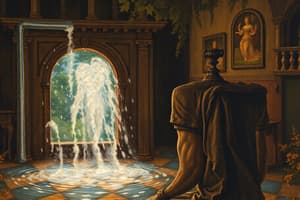Podcast
Questions and Answers
What is the second law of thermodynamics in relation to heat pump cycles?
What is the second law of thermodynamics in relation to heat pump cycles?
The second law of thermodynamics states that heat cannot spontaneously flow from a colder location to a hotter area; work is required to achieve this. This is relevant to heat pump cycles as they require work to transfer heat from a lower temperature location to a higher temperature location.
Explain the purpose of a heat pump and how it operates.
Explain the purpose of a heat pump and how it operates.
The purpose of a heat pump is to transfer heat from a lower temperature location to a higher temperature location. It can act as a heater by warming the higher temperature location or as a refrigerator or cooler by cooling the higher temperature location. The operating principle involves moving heat from a cold place to a warm place.
Who described the mathematical principles of an ideal heat engine and when?
Who described the mathematical principles of an ideal heat engine and when?
Sadi Carnot described the mathematical principles of an ideal heat engine using the Carnot cycle in 1824.
How does an air conditioner operate in relation to heat transfer?
How does an air conditioner operate in relation to heat transfer?
In what way can an ideal refrigerator or heat pump be conceptualized?
In what way can an ideal refrigerator or heat pump be conceptualized?
Flashcards are hidden until you start studying
Study Notes
Heat Pumps and Thermodynamics
- The second law of thermodynamics is essential in understanding heat pump cycles, as it describes the direction of spontaneous heat transfer and the concept of entropy.
Purpose and Operation of Heat Pumps
- A heat pump is a device that transfers heat from a colder location to a hotter location, often for heating, cooling, or refrigeration purposes.
- Heat pumps operate by using external energy to reverse the natural flow of heat, allowing heat to be transferred from a lower temperature to a higher temperature.
Ideal Heat Engine Principles
- Sadi Carnot, a French engineer, described the mathematical principles of an ideal heat engine in 1824.
- Carnot's work laid the foundation for the understanding of heat engine efficiency and the maximum possible efficiency (Carnot efficiency) of any heat engine.
Air Conditioner Operation
- An air conditioner operates by transferring heat from a cooler location (indoor air) to a hotter location (outdoor air) using a refrigerant that changes state from liquid to gas and back to liquid.
- The refrigeration cycle involves the circulation of refrigerant, allowing heat to be transferred from the indoor air to the outdoor air.
Ideal Refrigerators and Heat Pumps
- An ideal refrigerator or heat pump can be conceptualized as a reversible heat engine, meaning it can operate in both forward and reverse directions, with maximum efficiency.
- This idealized concept allows for the calculation of the maximum possible efficiency of real-world refrigeration and heat pump systems.
Studying That Suits You
Use AI to generate personalized quizzes and flashcards to suit your learning preferences.




